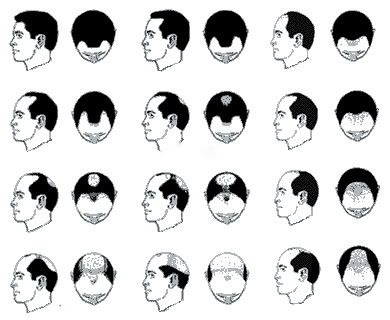
Male pattern baldness
Androgenic alopecia, also known as male pattern baldness, affects both men and women around the world. This is actually the single most common cause of permanent hair loss. Despite the fact there have been many myths propagated about the reasons for male pattern baldness, the simple truth is many people have a genetic predisposition for losing their hair.
Scientists have found multiple genes associated with hair loss. Most, though not all, are located on the sex linked chromosome identified as the X-chromosome. This means the genetic disposition for male pattern baldness is actually inherited from the female side of your family. In order for a woman to suffer hair loss in the typical male pattern, she would have to inherit multiple recessive genes that were reinforced by being present on both X-chromosomes.
The more direct cause of hair loss is a buildup of a hormone identified as dihydrotestosterone(DHT). This is considered to be a male hormone because it is a form of testosterone, but it is also produced in female bodies. Hence, the reason male pattern baldness can affect both sexes.
Scientists believe that androgenic alopecia evolved as a means of identifying more mature, socially settled males. Part of the reason for this belief stems from the fact that it affects not only human males, but also gorillas and orangutans.
The FDA has approved certain drugs as treatments for hair loss. The most commonly recognized of these is minoxydyl, normally sold under the trade name, Rogaine. Additional treatments include the application of topical caffeine and certain types of aloe vera based gels. Doctors can also prescribe a tablet taken orally containing the drug finasteride.
Both the drugs minoxydyl and finasteride work by reducing the amount of DHT present in the hair follicles. Other treatments work in different ways. In general, the best that can be hoped for is a cessation of additional hair loss. Only in extremely rare cases is the condition reversible.
In addition to the above listed treatments, several surgical procedures that involve transplanting hair, usually from the back of the head, into areas where hair is thinning have been created. Advances continue to be made in the process of surgically replacing lost hair. Unfortunately, the price continues to be more than the average male can afford.
Male pattern baldness affects a large percentage of people. Many have decided to simply live with the effects and let their hair go naturally. Others seek treatments designed to reduce or stop hair loss. When possible, they prefer treatments to cause new growth to replace lost hair.



